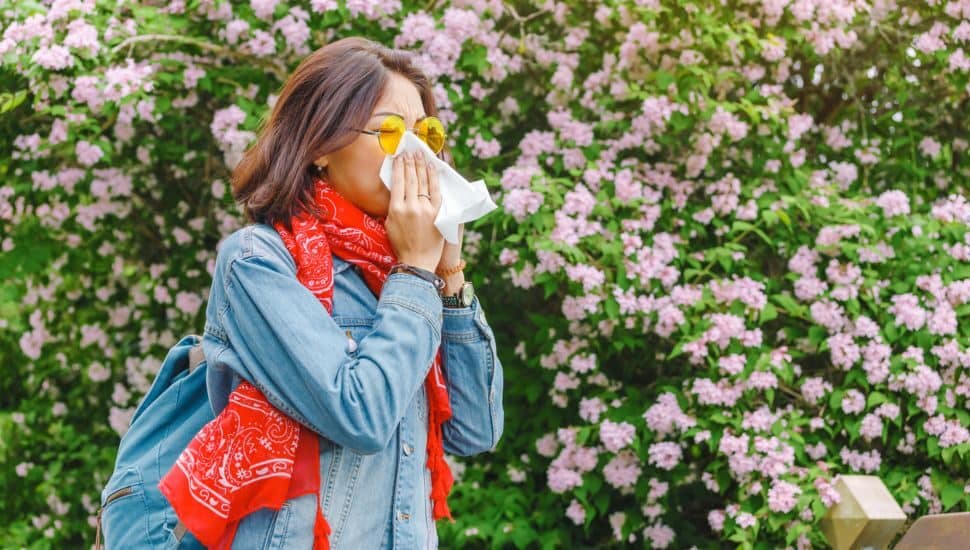Spring is Here, And So Are Spring Allergies — What Now?

Warmer temperatures, longer days, and blooming flowers are all reasons to get excited about spring. But if the smell of fresh flowers also means an increase in sneezing or itching, the start of spring may not be as bright as it could be.
If you are balancing spring fun with seasonal allergies, you are not alone. It can be tempting to just power through, but there’s actually a lot you can do to manage your symptoms.
Here are three tips to help you find relief from spring allergies.
1. Keep Track of Pollen Counts
When you think of spring allergies, the first thing that might come to mind is pollen. Plants produce pollen during the spring, summer, and fall — making it an almost year-round allergen. While pollen is needed for plants to fertilize, it can be pretty annoying when it’s making you sneeze.
You can do your allergies a favor by treating your symptoms and by limiting certain experiences that make them worse.
Keeping track of pollen levels also means knowing what time of day might be the biggest trigger for your allergies. During the spring and summer seasons, pollen levels are at their highest in the evenings.
If you’re thinking about having an outdoor picnic or spending some time in nature, aim for the morning and afternoon to limit the amount of pollen that might be in the air.
2. Steer Clear of Mold
While pollen might be the allergen people pay the most attention to — it’s not the only one. In addition to pollen, your allergies might also be bothered by mold.
Mold can grow at any time during the year, but it especially loves growing when the temperature, rain levels, or humidity levels change. Sound familiar?
Spring is a great time of year for mold and mildew to form and it can be tough on your allergies.
Doing yard work or tending to a garden are key places where you might come into contact with mold (and pollen). That wet leaf pile that’s been sitting in the corner of your yard is a perfect spot for mold to grow.
While getting your yard ready for spring and summer, keep in mind that pollen and mold might make your symptoms worse. If you are going to be doing yard work, you can buy a particle mask at a hardware store to stop small particles from getting into your nose and lungs.
3. Reduce Allergies at Home
A lot of your spring allergies are caused by what is going on outside. But when those allergens get inside your house, you may find that your symptoms are happening more frequently.
Thankfully, there are some easy steps you can take to protect your home from different allergens:
Pollen: If you have your windows open to let in some fresh air, you may also be letting pollen into your home too. Watch local news sources for pollen counts — on days when the pollen count is high, you may want to keep your windows closed.
Mold: To keep mold to a minimum inside your house, it’s helpful to keep the humidity level low (under 45%). A dehumidifier can help. For mold around the house, keep an eye on places that can fill with water, like plant pots, buckets, or garbage cans.
Dust: Another indoor allergen that can get kicked up during the spring is dust. If you find yourself doing a lot of spring cleaning, you may be shifting around dust particles that can be annoying — and trigger your allergies. To stay on top of dust in your home, vacuum often (once or twice a week), and consider covers for your mattress and pillows.
You can also consider different air cleaners with “CERTIFIED Asthma & Allergy Friendly®” filters that can help with a range of allergens. From portable to whole-home air-cleaning systems, these types of products can filter almost 98% of the allergy-causing particles that float around your home.
Don’t Forget to Talk to Your Primary Care Provider
While there are many steps you can take to limit the allergens you come into contact with — it’s not the whole story. There are many different types of pollen, and it can be tough to know exactly what is causing you to react a certain way. Even if pollen counts are low, one specific type of pollen nearby may make you cough or sneeze.
More than 66% of people who have spring allergies actually have symptoms year-round. Because of this, it can be helpful to learn more about your specific allergies by talking to your Chester County Hospital primary care provider.
Your primary care provider can help you pinpoint what allergens are triggers for a reaction. They can also refer you to an allergy specialist, who can conduct an allergy test and determine how to treat your symptoms best.
Spring comes once a year, but your allergies don’t have to. With a few reminders and the help of your Chester County Hospital provider, you can enjoy a sneeze-free spring.
Learn more at Chester County Hospital.
Connect With Your Community
Subscribe to stay informed!
"*" indicates required fields








































![95000-1023_ACJ_BannerAd[1]](https://vista.today/wp-content/uploads/2023/03/95000-1023_ACJ_BannerAd1.jpg)








